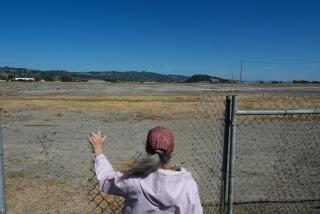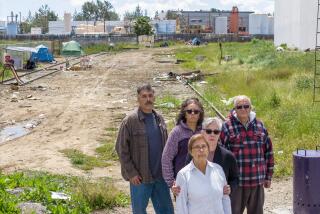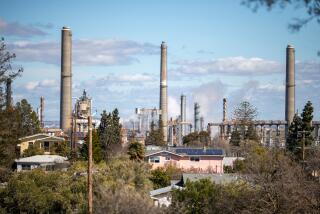Dispute Delays Cleanup of Contaminated Waste in Oxnard
Removal of contaminated waste at an Oxnard smelting plant has been delayed as plant officials and environmentalists squabble over the best way to begin cleaning up the mess without harming nearby wetlands.
Halaco Engineering Co. failed this week to obtain city permission to use a dirt road jointly owned by the Metropolitan Water District and Oxnard’s Community Development Commission, an Oxnard business leader said.
City officials declined to comment on a closed meeting Tuesday regarding Halaco’s request.
Halaco’s operators sought use of the road for access to aging wells that must be removed as part of a state-ordered cleanup of contaminated water from a slag heap on the Ormond Beach site.
But environmentalists had urged the City Council to reject Halaco’s request, saying large trucks on the road would harm the very wetlands the state is trying to protect.
City Council discussion of the permit ended Tuesday evening without a vote, said Steve Kinney, president of the Greater Oxnard Economic Development Corp.
The road sought for access bisects much of the protected wetlands, prompting an angry response from environmentalists.
“You should take actions against [Halaco’s] illegal encroachment on the wetlands instead of partnering with the company,” Damon Wing, programs director of the environmental group Ventura CoastKeeper, told the council members at an earlier meeting.
Halaco officials said they are trying to comply with orders from the Los Angeles Regional Water Quality Control Board, which has required the company to replace inoperable water-monitoring wells with new equipment to help stem daily discharges of soupy waste produced by the plant.
In March, the water quality board directed Halaco to stop the discharges that have been flowing since 1970, yielding a 40-foot-high slag heap near the wetlands.
The discharges, which amount to half a million gallons of contaminated water each month, must end by December. The slag heap must be removed within 10 years.
Removal of the old wells should have been started earlier, said Dave Gable, one of Halaco’s owners.
Gable said Halaco needs access to the city’s 15-foot-wide road--an extension of McWane Boulevard--so it can reach contaminated areas on the eastern portion of the plant.
The plant’s internal roads cannot accommodate the large trucks needed to haul away the dismantled wells and bring new equipment to the site, he said.
Halaco’s next step is not clear, company officials said.
“We have not been informed of anything,” Halaco’s attorney, Arthur Fine, said. “We have no permit yet, but we still need access,” he said.
Environmentalists said Halaco is not being creative enough.
“We want to see why they need trucks,” said Drew Bohan, executive director of Santa Barbara ChannelKeeper. “We’re not talking about big, old-fashioned wells. They could be removed manually.”
Bohan and others said Halaco has already done enough environmental damage by allowing its slag heap to seep into the sensitive wetlands. Halaco officials said the company has not harmed the wetlands.
Gable said an industrial drill could not be carried in without a truck. And Fine said removal of the wells would have required only a handful of trips by one truck over four months.
The company is seeking access to the road for well removal, Fine said. Removal of the slag heap has not been addressed yet.
“There is no building, digging, paving. They’re just running a truck with rubber tires over dirt,” Fine said.
Gable said a preliminary road permit issued by the Metropolitan Water District in May was stalled after environmentalists learned of the company’s request.
He added that Halaco has used the road informally for many years.
More to Read
Sign up for Essential California
The most important California stories and recommendations in your inbox every morning.
You may occasionally receive promotional content from the Los Angeles Times.









